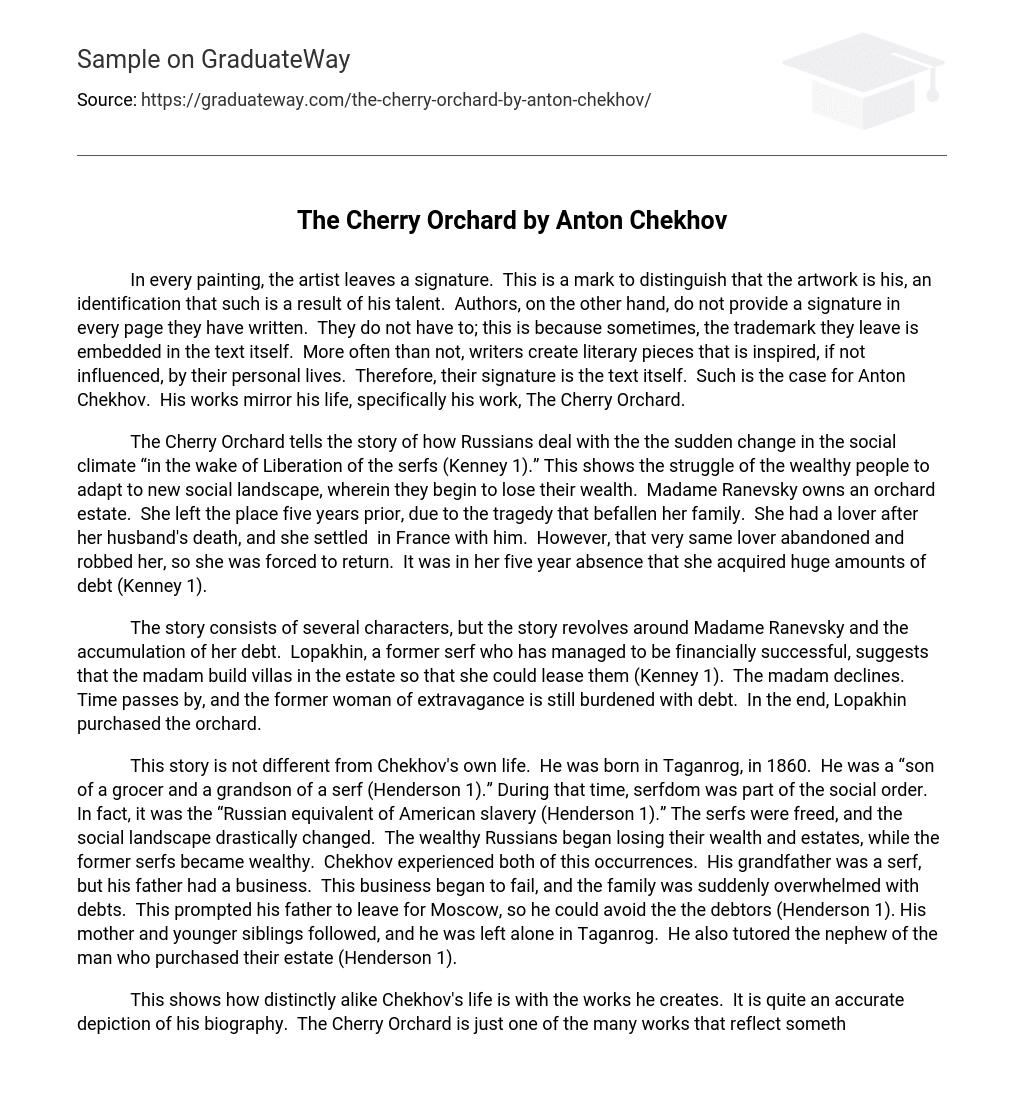In every painting, the artist leaves a signature. This is a mark to distinguish that the artwork is his, an identification that such is a result of his talent. Authors, on the other hand, do not provide a signature in every page they have written. They do not have to; this is because sometimes, the trademark they leave is embedded in the text itself. More often than not, writers create literary pieces that is inspired, if not influenced, by their personal lives. Therefore, their signature is the text itself. Such is the case for Anton Chekhov. His works mirror his life, specifically his work, The Cherry Orchard.
The Cherry Orchard tells the story of how Russians deal with the the sudden change in the social climate “in the wake of Liberation of the serfs (Kenney 1).” This shows the struggle of the wealthy people to adapt to new social landscape, wherein they begin to lose their wealth. Madame Ranevsky owns an orchard estate. She left the place five years prior, due to the tragedy that befallen her family. She had a lover after her husband’s death, and she settled in France with him. However, that very same lover abandoned and robbed her, so she was forced to return. It was in her five year absence that she acquired huge amounts of debt (Kenney 1).
The story consists of several characters, but the story revolves around Madame Ranevsky and the accumulation of her debt. Lopakhin, a former serf who has managed to be financially successful, suggests that the madam build villas in the estate so that she could lease them (Kenney 1). The madam declines. Time passes by, and the former woman of extravagance is still burdened with debt. In the end, Lopakhin purchased the orchard.
This story is not different from Chekhov’s own life. He was born in Taganrog, in 1860. He was a “son of a grocer and a grandson of a serf (Henderson 1).” During that time, serfdom was part of the social order. In fact, it was the “Russian equivalent of American slavery (Henderson 1).” The serfs were freed, and the social landscape drastically changed. The wealthy Russians began losing their wealth and estates, while the former serfs became wealthy. Chekhov experienced both of this occurrences. His grandfather was a serf, but his father had a business. This business began to fail, and the family was suddenly overwhelmed with debts. This prompted his father to leave for Moscow, so he could avoid the the debtors (Henderson 1). His mother and younger siblings followed, and he was left alone in Taganrog. He also tutored the nephew of the man who purchased their estate (Henderson 1).
This shows how distinctly alike Chekhov’s life is with the works he creates. It is quite an accurate depiction of his biography. The Cherry Orchard is just one of the many works that reflect something more than Chekhov’s exceptional talent of writing. His life is his trademark, as his experiences as his signature in all his texts.
Works Cited
Kenney, Sarah. GradeSaver. 11 December 2007 <http://www.gradesaver.com/classicnotes/titles/cherry/shortsumm.html>.
Henderson, Monica. Sparknote on The Seagull. 11 December 2007 <http://www.sparknotes.com/drama/seagull/context.html>.





